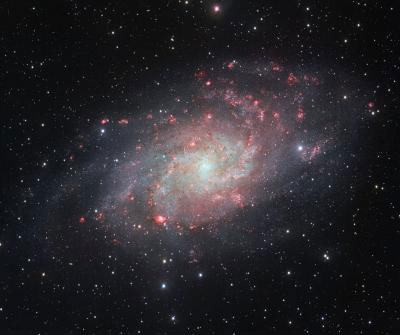 The VLT Survey Telescope at ESO's Paranal Observatory in Chile has captured a beautifully detailed image of the galaxy Messier 33. This nearby spiral, the second closest large galaxy to our own galaxy, is packed with bright star clusters, and clouds of gas and dust. The new picture is amongst the most detailed wide-field views of this object ever taken and shows the many glowing gas clouds in the spiral arms with particular clarity.
The VLT Survey Telescope at ESO's Paranal Observatory in Chile has captured a beautifully detailed image of the galaxy Messier 33. This nearby spiral, the second closest large galaxy to our own galaxy, is packed with bright star clusters, and clouds of gas and dust. The new picture is amongst the most detailed wide-field views of this object ever taken and shows the many glowing gas clouds in the spiral arms with particular clarity.
Aug 6th, 2014
Read more
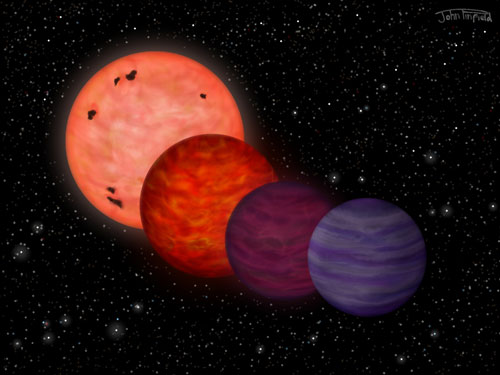 Astronomers have discovered an extremely cool object that could have a particularly diverse history - although it is now as cool as a planet, it may have spent much of its youth as hot as a star.
Astronomers have discovered an extremely cool object that could have a particularly diverse history - although it is now as cool as a planet, it may have spent much of its youth as hot as a star.
Aug 5th, 2014
Read more
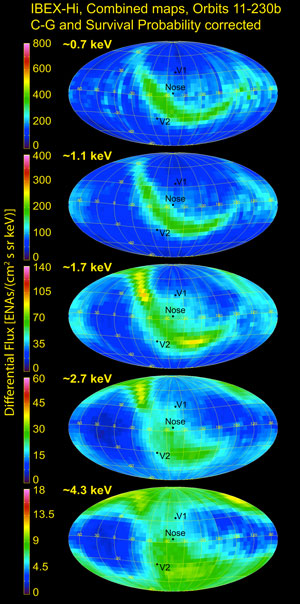 Scientists yesterday highlighted an impressive list of achievements in researching the outer heliosphere at the 40th International Committee on Space Research Scientific Assembly in Moscow.
Scientists yesterday highlighted an impressive list of achievements in researching the outer heliosphere at the 40th International Committee on Space Research Scientific Assembly in Moscow.
Aug 4th, 2014
Read more
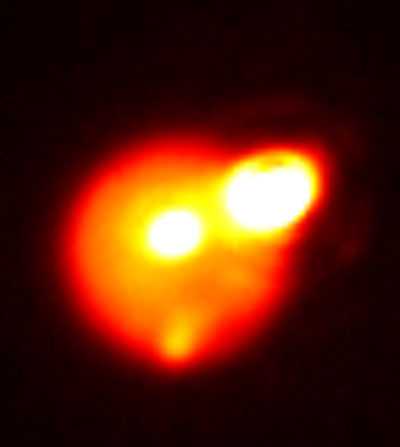 An image from the Gemini Observatory captures what is one of the brightest volcanoes ever seen in our solar system. The image, obtained on Aug. 29, reveals the magnitude of the eruption that was the 'grand finale' in a series of eruptions on the distant moon.
An image from the Gemini Observatory captures what is one of the brightest volcanoes ever seen in our solar system. The image, obtained on Aug. 29, reveals the magnitude of the eruption that was the 'grand finale' in a series of eruptions on the distant moon.
Aug 4th, 2014
Read more
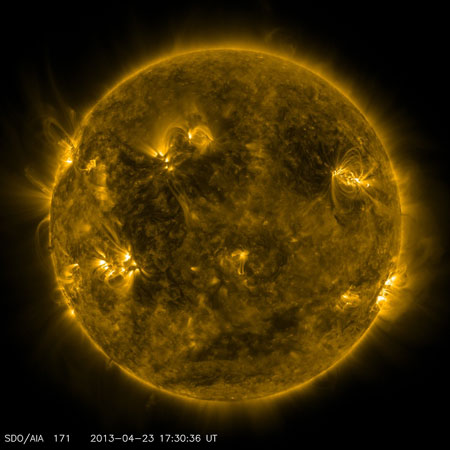 Scientists have recently gathered some of the strongest evidence to date to explain what makes the sun's outer atmosphere so much hotter than its surface. The new observations of the small-scale extremely hot temperatures are consistent with only one current theory: something called nanoflares - a constant peppering of impulsive bursts of heating, none of which can be individually detected - provide the mysterious extra heat.
Scientists have recently gathered some of the strongest evidence to date to explain what makes the sun's outer atmosphere so much hotter than its surface. The new observations of the small-scale extremely hot temperatures are consistent with only one current theory: something called nanoflares - a constant peppering of impulsive bursts of heating, none of which can be individually detected - provide the mysterious extra heat.
Aug 1st, 2014
Read more
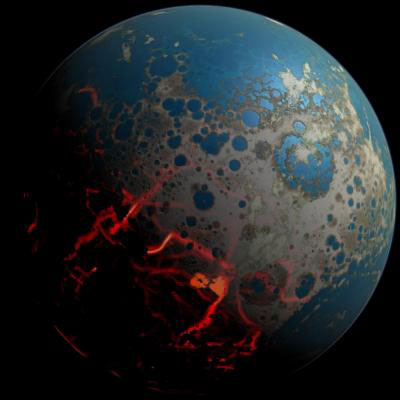 New research shows that more than four billion years ago, the surface of Earth was heavily reprocessed as a result of giant asteroid impacts. A new model based on existing lunar and terrestrial data sheds light on the role asteroid bombardments played in the geological evolution of the uppermost layers of the Hadean Earth.
New research shows that more than four billion years ago, the surface of Earth was heavily reprocessed as a result of giant asteroid impacts. A new model based on existing lunar and terrestrial data sheds light on the role asteroid bombardments played in the geological evolution of the uppermost layers of the Hadean Earth.
Jul 31st, 2014
Read more
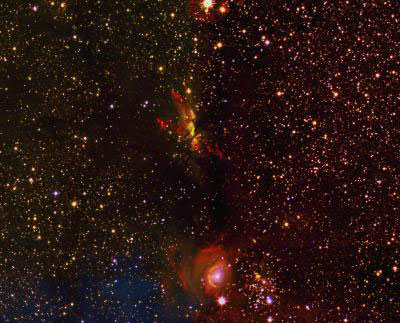 Preliminary research findings from the University of Kent have identified hundreds of so far unknown jets from young stars, as well as numerous new planetary nebulae in the Galactic Plane.
Preliminary research findings from the University of Kent have identified hundreds of so far unknown jets from young stars, as well as numerous new planetary nebulae in the Galactic Plane.
Jul 31st, 2014
Read more
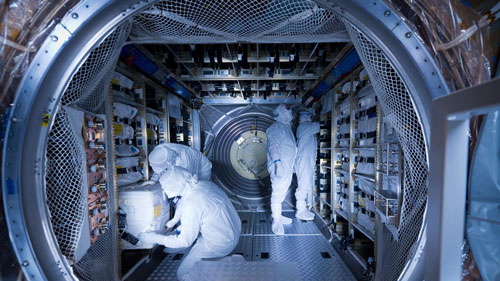 So far, four European space freighters have carried supplies to the International Space Station (ISS). At 01:47 CEST on 30 July 2014, Georges Lemaitre - the fifth and last European Space Agency (ESA) Automated Transfer Vehicle (ATV) - lifted off from the spaceport at Kourou in French Guiana.
So far, four European space freighters have carried supplies to the International Space Station (ISS). At 01:47 CEST on 30 July 2014, Georges Lemaitre - the fifth and last European Space Agency (ESA) Automated Transfer Vehicle (ATV) - lifted off from the spaceport at Kourou in French Guiana.
Jul 30th, 2014
Read more
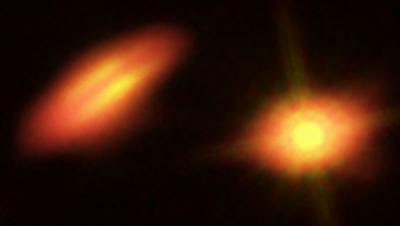 While surveying a series of binary stars, astronomers uncovered a striking pair of wildly misaligned planet-forming disks in the young binary star system HK Tau.
While surveying a series of binary stars, astronomers uncovered a striking pair of wildly misaligned planet-forming disks in the young binary star system HK Tau.
Jul 30th, 2014
Read more
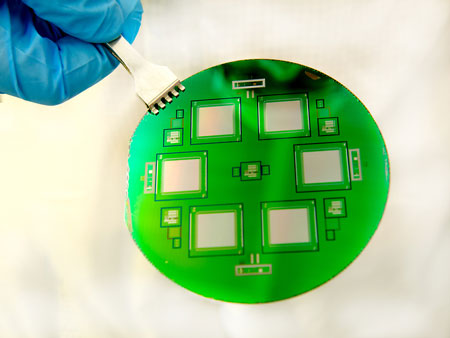 NASA technologists have hurdled a number of significant technological challenges in their quest to improve an already revolutionary observing technology originally created for the James Webb Space Telescope.
NASA technologists have hurdled a number of significant technological challenges in their quest to improve an already revolutionary observing technology originally created for the James Webb Space Telescope.
Jul 30th, 2014
Read more
The Milky Way is less massive than astronomers previously thought, according to new research. For the first time, scientists have been able to precisely measure the mass of the galaxy that contains our Solar system.
Jul 30th, 2014
Read more
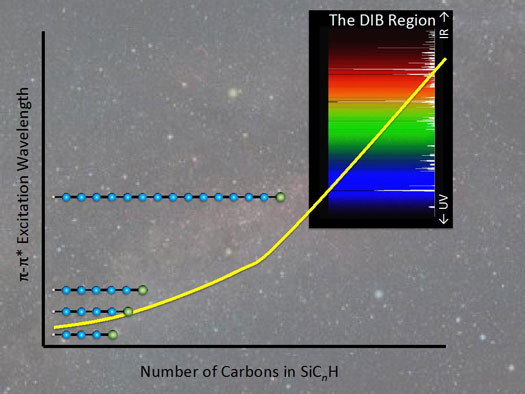 A group of scientists has offered a tantalizing new possibility: these mysterious molecules may be silicon-capped hydrocarbons like SiC3H, SiC4H and SiC5H, and they present data and theoretical arguments to back that hypothesis.
A group of scientists has offered a tantalizing new possibility: these mysterious molecules may be silicon-capped hydrocarbons like SiC3H, SiC4H and SiC5H, and they present data and theoretical arguments to back that hypothesis.
Jul 29th, 2014
Read more
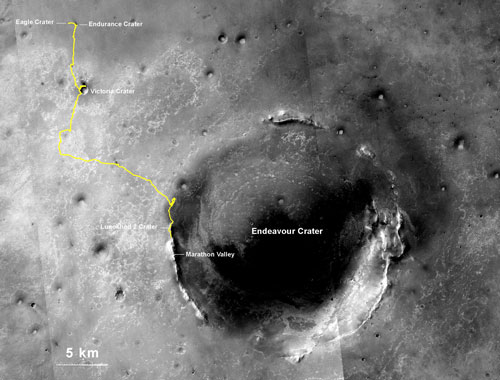 NASA's Opportunity Mars rover, which landed on the Red Planet in 2004, now holds the off-Earth roving distance record after accruing 25 miles (40 kilometers) of driving. The previous record was held by the Soviet Union's Lunokhod 2 rover.
NASA's Opportunity Mars rover, which landed on the Red Planet in 2004, now holds the off-Earth roving distance record after accruing 25 miles (40 kilometers) of driving. The previous record was held by the Soviet Union's Lunokhod 2 rover.
Jul 28th, 2014
Read more
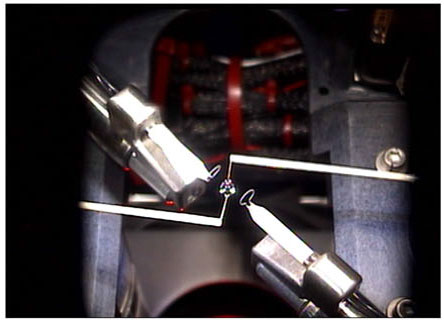 A team of international researchers has discovered a new type of cool burning flames that could lead to cleaner, more efficient engines for cars. The discovery was made during a series of experiments on the International Space Station.
A team of international researchers has discovered a new type of cool burning flames that could lead to cleaner, more efficient engines for cars. The discovery was made during a series of experiments on the International Space Station.
Jul 28th, 2014
Read more
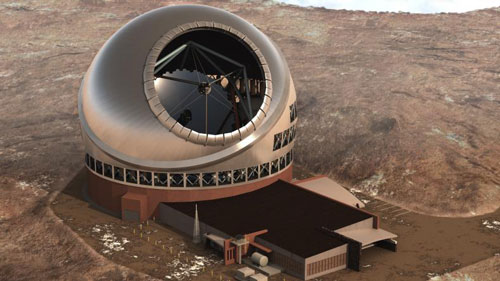 Following the approval of a sublease on July 25 by the Hawaii Board of Land and Natural Resources, the Thirty Meter Telescope (TMT) announces the beginning of the construction phase on Hawaii Island.
Following the approval of a sublease on July 25 by the Hawaii Board of Land and Natural Resources, the Thirty Meter Telescope (TMT) announces the beginning of the construction phase on Hawaii Island.
Jul 28th, 2014
Read more
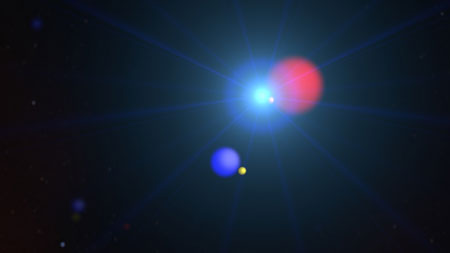 A recent study shows that the emission is dominated by the local hot bubble of gas - 1 million degrees - with, at most, 40 percent of emission originating within the solar system. The findings should put to rest the disagreement about the origin of the X-ray emission and confirm the existence of the local hot bubble.
A recent study shows that the emission is dominated by the local hot bubble of gas - 1 million degrees - with, at most, 40 percent of emission originating within the solar system. The findings should put to rest the disagreement about the origin of the X-ray emission and confirm the existence of the local hot bubble.
Jul 28th, 2014
Read more
 OSIRIS images of Rosetta's comet resolve structures at 100 metres pixel scale.
OSIRIS images of Rosetta's comet resolve structures at 100 metres pixel scale.
Jul 24th, 2014
Read more
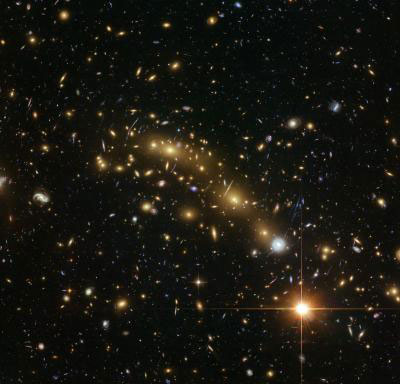 Astronomers using the Hubble Space Telescope have mapped the mass within a galaxy cluster more precisely than ever before. Created using observations from Hubble's Frontier Fields observing programme, the map shows the amount and distribution of mass within MCS J0416.1-2403, a massive galaxy cluster found to be 160 trillion times the mass of the Sun.
Astronomers using the Hubble Space Telescope have mapped the mass within a galaxy cluster more precisely than ever before. Created using observations from Hubble's Frontier Fields observing programme, the map shows the amount and distribution of mass within MCS J0416.1-2403, a massive galaxy cluster found to be 160 trillion times the mass of the Sun.
Jul 24th, 2014
Read more
 The VLT Survey Telescope at ESO's Paranal Observatory in Chile has captured a beautifully detailed image of the galaxy Messier 33. This nearby spiral, the second closest large galaxy to our own galaxy, is packed with bright star clusters, and clouds of gas and dust. The new picture is amongst the most detailed wide-field views of this object ever taken and shows the many glowing gas clouds in the spiral arms with particular clarity.
The VLT Survey Telescope at ESO's Paranal Observatory in Chile has captured a beautifully detailed image of the galaxy Messier 33. This nearby spiral, the second closest large galaxy to our own galaxy, is packed with bright star clusters, and clouds of gas and dust. The new picture is amongst the most detailed wide-field views of this object ever taken and shows the many glowing gas clouds in the spiral arms with particular clarity.
 Subscribe to our Space Exploration News feed
Subscribe to our Space Exploration News feed














